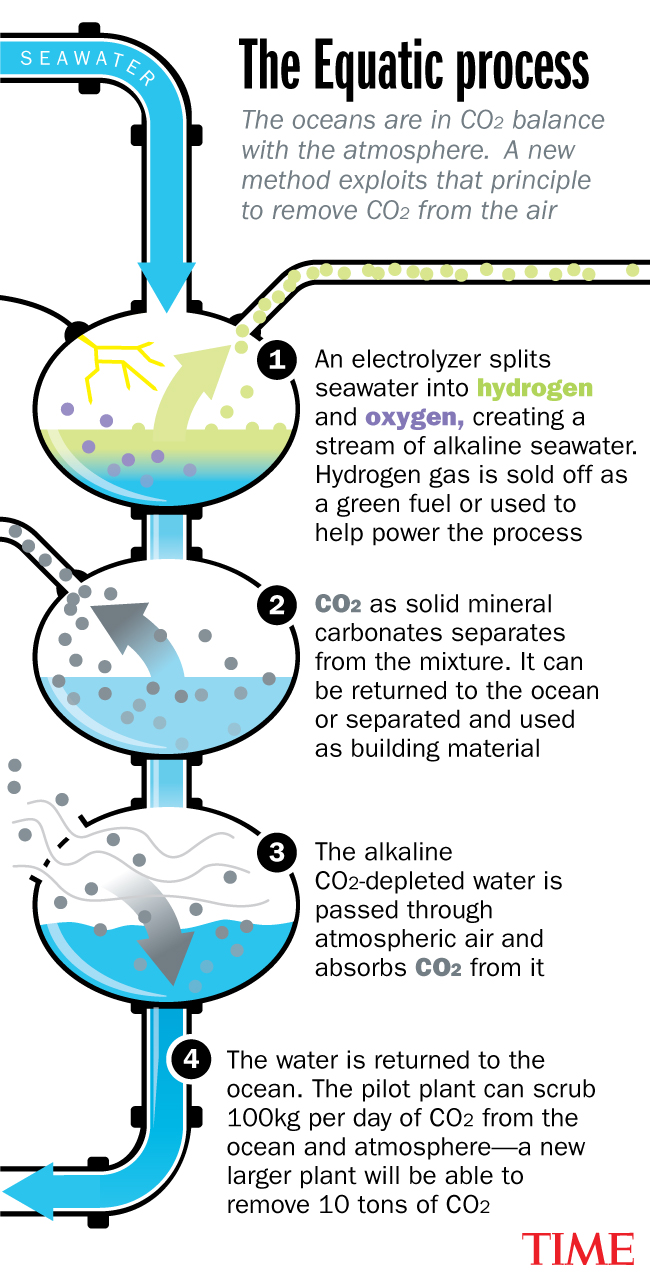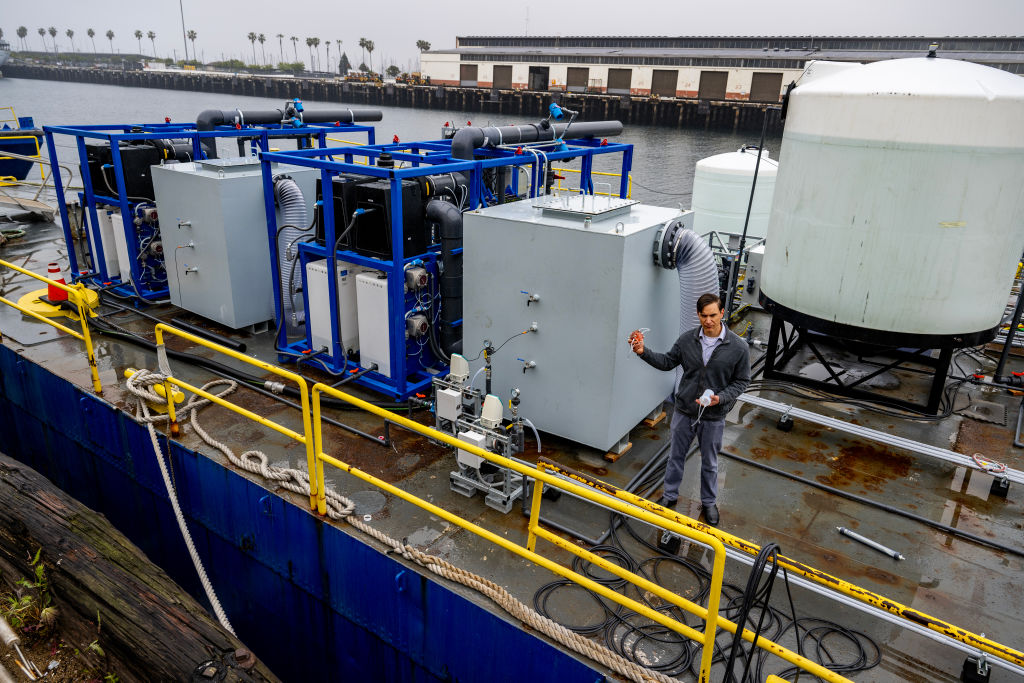Back in 2012, a California businessman sailed a boat into the waters off western Canada and dumped 100 tons of iron filings into the Pacific Ocean. The goal was to to spawn an enormous bloom of phytoplankton, which would take in carbon dioxide as they grew, then die and fall to the bottom of the ocean, presumably locking away the greenhouse gasses, and helping to save the world from climate change.
It didn’t go over well. As details of the project came to light, many observers assailed it as an unscientific stunt, saying that it had endangered marine ecosystems without taking proper steps to verify if it had actually permanently removed carbon from the atmosphere. Other proposals to use the oceans to draw down atmospheric carbon dioxide took a reputational hit, now linked in the eyes of the public with the notion of rogue geoengineering experiments and dubious green business plans.
Things have changed a lot since then. These days, proposals to leverage the chemistry of the oceans to buy the world time in the fight against climate change are raking in millions of dollars in venture capital funding and lucrative contracts to offset the emissions of some of the world’s biggest companies. The world’s oceans already function as an enormous carbon sink, absorbing about one quarter of humanity’s CO2 emissions. The new projects are pledging that they can amplify that ability, seemingly a godsend in a world plagued by runaway emissions, and with little time left to act.
But such proposals also occupy a tricky space in the climate world. No companies currently pledging to sequester carbon emissions, either on oceans or on land, are operating anywhere close to a scale that would make a difference. Even if they were to massively expand their machinery, technology to pull carbon dioxide out of the atmosphere wouldn’t do much if it isn’t accompanied by deep emissions cuts. Some expert observers worry that focusing on the carbon removal technology is a distraction from the more crucial issue of reining in emissions.
The problem is, emission reductions aren’t happening fast enough. That makes it increasingly likely that the world will have to find some way of removing billions of tons of carbon emissions from the atmosphere within the next 30 years. To have any prospect of that technology being available on the gargantuan scale that may become necessary, we will need to begin investing in it now.

Much of the public focus to date has centered on land based carbon removal companies, like Switzerland-based Climeworks and Canadian startup Carbon Engineering, which have attracted hundreds of millions of dollars in venture capital. Those companies plan to build massive machines that will suck CO2 out of the air and store it deep underground. But in the past six months, start ups saying they can use the oceans to do much the same thing have been pulling in tens of millions of dollars in new funding. Others have begun signing deals to offset tens of thousands of tons of emissions from large companies. Still, questions remain about the effects that some of the approaches may have on ecosystems, and if all the carbon that some companies say they can put into the world’s oceans will really stay there.
Read more: Why Investors Are Betting Big on Carbon Removal Technology
Ocean carbon removal startups are proposing a wide spectrum of approaches. Ebb Carbon, based in San Carlos, Calif., plans to use electricity to make ocean water more alkaline, which the company says would cause it to absorb more CO2 from the atmosphere. Funders poured in $20 million in venture capital in April to build the company’s first small-scale plant. Captura, based in Pasadena, wants to remove carbon dioxide gas dissolved in ocean water, and then either pump it underground or use it as feedstock for industrial processes. The idea is that the ocean will replace the lost CO2 by absorbing more carbon from the air. The company received $12 million in investment in January from backers that include the venture capital arm of Saudi Arabia’s state-owned oil company. RunningTide, based in Portland, Maine, signed an agreement in March to remove 12,000 tons of CO2 for Microsoft. Its plans hinge on sequestering carbon dioxide dissolved in the oceans with seaweed, which absorbs CO2 as it grows.
Equatic, another California-based company, signed an agreement to remove 62,000 tons of carbon on behalf of aerospace giant Boeing earlier this summer. Originally spun out of experiments at University of California, Los Angeles, its technology combines principles from direct air carbon capture, like the Climeworks Orca plant, with the approach of increasing the ocean’s alkalinity (the ocean becomes more acidic as it absorbs CO2, while adding alkalinity, in theory, allows the ocean to absorb more carbon). At its pilot plant at the Port of Los Angeles, the company uses electricity to separate seawater into oxygen and hydrogen, which can be sold as fuel for zero carbon transport or industrial processes, or used to help power Equatic’s equipment. The electrical charges create two streams of seawater, one acidic, the other alkaline. The company adds minerals to bring the acidic seawater back to a normal pH, then releases it into the ocean. The alkaline seawater, meanwhile, releases carbon as specks of solid mineral, and the company then passes air through the alkaline, CO2-depleted seawater to absorb more carbon dioxide.

The pilot plant can remove about 100 kilograms of CO2 from the atmosphere every day, which is equivalent to the daily emissions of about eight automobiles. They plan to soon build a larger one that could process 100 times more carbon. That’s still a microscopic drop on the bucket compared to the scale of the world’s CO2 problem. But Edward Sanders, Equatic’s chief operating officer, says the oceans can soon play a major part in averting climate catastrophe. “There’s 38,000 gigatons of dissolved organic carbon in the oceans today,” he says. “That’s an extraordinary amount. So we’re confident that if we were to use the Equatic process, then the [carbon] capacity is there.”
The main problem that remains, Sanders says, is to find a way to scale up the company’s technology quickly enough to make a difference. “It’s halfway through 2023. We’ve got to do this quickly.”

Still, some experts think that some of the companies trying to sell ocean carbon removal may be moving too fast. There’s a lot of unanswered questions about how various proposals to sequester carbon in the ocean could affect marine biodiversity, as well as fish stocks that millions of people depend on for food. No one knows, for instance, how massive floating kelp farms could affect ocean life. And there’s also scientific uncertainty about how much of the carbon dioxide that companies are proposing to put into the oceans would really stay there.
Read more: All the Ways to Remove Carbon Emissions From the Air
Matthew Long, a scientist in the oceanography section of the federally funded National Center for Atmospheric Research, says no one has developed the type of sophisticated computer models that companies would need in order to have a good idea of how much carbon they’re trapping in the ocean. He’s trying to attract about $50 million of philanthropic funding to build one, a task he says no carbon removal startup will be able to do on its own. Speed, he says, is of the essence. “The requirements for ramping up carbon removal are so dramatically challenging that it’s really an all hands on deck moment for the scientific community.”
Sifang Chen, a science advisor at climate nonprofit Carbon180, singles out Equatic as one of the companies that likely has more certainty about how much carbon they would be putting in the ocean, since they actually mix CO2 into seawater in their plants, rather than altering the chemistry of the surrounding ocean water and hoping the larger system acts as they expect. But she says she’s worried about other companies selling carbon removal credits without proving that their solutions really work as they say. She’s also concerned about a dearth of regulation for carbon removal projects on the open ocean. Any company might start testing a risky, speculative solution on a mass scale, potentially producing another public backlash like what happened after the experiment off western Canada a decade ago.
“That’s [part of what] I’m really worried about,” says Chen, who supports further research to develop ocean carbon dioxide removal, “that before this sector can take off, the public trust for it is already gone.”
More Must-Reads from TIME
- How Donald Trump Won
- The Best Inventions of 2024
- Why Sleep Is the Key to Living Longer
- Robert Zemeckis Just Wants to Move You
- How to Break 8 Toxic Communication Habits
- Nicola Coughlan Bet on Herself—And Won
- Why Vinegar Is So Good for You
- Meet TIME's Newest Class of Next Generation Leaders
Write to Alejandro de la Garza at alejandro.delagarza@time.com
